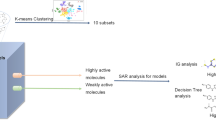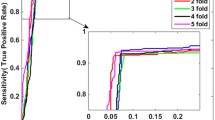Abstract
We previously investigated the classification and prediction of dopamine D1 receptor agonists and antagonists using a topological fragment spectra (TFS)-based support vector machine (SVM), in which the dataset contained noise compounds that had no D1 receptor activity. This work extended the dataset to seven activity classes (dopamine D1, D2, and auto-receptor agonists, and D1, D2, D3, and D4 antagonists) and increased the noise ratio to ten times that of active compounds. In total, this study used 16,008 compounds for training and 1,779 compounds for prediction. The TFS-based SVM gave good, stable results for both classification and prediction, even in the case that included ten times the noise data. The resulting model correctly predicted 97.6% of the prediction set of 1,779 compounds.
Similar content being viewed by others
References
Fujishima, S. and Takahashi, Y., “Classification of Dopamine Antagonists Using TFS-Based Artificial Neural Network,” J. Chem. Inf. Comput. Sci. 44, pp.1006-1009, 2004.
Takahashi, Y., Nishikoori, K. and Fujishima, S. “Classification of Pharmacological Activity of Drugs Using Support Vector Machine,” in Second Int. Workshop on Active Mining, pp.152-158, 2003.
Takahashi, Y., Fujishima, S., Nishikoori, K., Kato, H. and Okada, T., “Identification of Activity Classes of Drugs under Existing Noise Compounds by ANN and SVM,” in Third Int. Workshop on Active Mining, pp.93-101, 2004.
MDL, MDL Drug Data Report, ver.2001.1, 2001.
Takahashi, Y., Ohoka, H. and Ishiyama Y., “Structural Similarity Analysis Based on Topological Fragment Spectra,” in Advances in Molecular Similarity, (Eds. R. Carbo & P. Mezey), JAI Press, Greenwich, CT, 2, pp.93-104, 1998.
Vapnik, V. N., The Nature of Statistical Learning Theory, Springer, 1995.
Platt, J. C., “Sequential Minimal Optimization, A Fast Algorithm for Training Support Vector Machines,” Microsoft Research Tech. Report MSR-TR-98-14, Microsoft Research, 1998.
Author information
Authors and Affiliations
Corresponding author
About this article
Cite this article
Fujishima, S., Takahashi, Y., Nishikori, K. et al. Extended Study of the Classification of Dopamine Receptor Agonists and Antagonists using a TFS-based Support Vector Machine. New Gener. Comput. 25, 203–212 (2007). https://doi.org/10.1007/s00354-007-0012-x
Received:
Revised:
Published:
Issue Date:
DOI: https://doi.org/10.1007/s00354-007-0012-x




